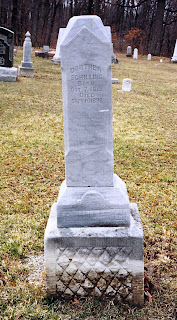For one thing, I spend a lot of time indoors. I work inside and my favorite activities in my non-work time (those that don't have to do with things my teenage sons are doing) are things like genealogy searching on the computer, writing family history on the computer, checking in with my friends on Facebook ... you get the picture. Getting to a cemetery is my (warped?) way of communing with nature.
One of the first things I did almost thirty years ago when I started doing genealogy was visit a cemetery in Grant County, Indiana, where my great-great-grandfather, Daniel Krinn, was buried. I can still remember the feeling I had when I stood in front of his cemetery marker - a feeling like I had started down a path that meant something special. I still feel that way about genealogy.
 Visiting a cemetery in person can give you insights that you can't really get from a cemetery book or a website - a look at the landscape that was likely quite familiar to the family, the shape and size of the stones your family members chose. Did this indicate that they were poor? Well off? Or perhaps well-off, but frugal (don't say cheap!) in choosing a smallish, non-ornate stone? The stones tell a lot about the time period, as well, since shapes of markers and materials used to make them were in favor at different times, and even varied by region. Some cemetery transcription books will include notations about icons or symbols on the stones and epitaphs - poetic verses that don't include reference to the person's specific vital statistics - but many do not. These are things you can find when you go to the cemetery.
Visiting a cemetery in person can give you insights that you can't really get from a cemetery book or a website - a look at the landscape that was likely quite familiar to the family, the shape and size of the stones your family members chose. Did this indicate that they were poor? Well off? Or perhaps well-off, but frugal (don't say cheap!) in choosing a smallish, non-ornate stone? The stones tell a lot about the time period, as well, since shapes of markers and materials used to make them were in favor at different times, and even varied by region. Some cemetery transcription books will include notations about icons or symbols on the stones and epitaphs - poetic verses that don't include reference to the person's specific vital statistics - but many do not. These are things you can find when you go to the cemetery.I have found at least two epitaphs on ancestors' cemetery markers. John Blair's marker in Pine Corners Cemetery, Gorham, New York (died 28 September 1814), says:
"In slumbers deep my body lies,
My soul has left his clay,
To soar above in wolds of love,
There shines eternal day."
In Clinker Cemetery, Defiance County, Ohio, Dorothea (Abel) Schilling's marker (died 10 September 1892) says:
"A precious one from us is gone,
A voice we loved is stilled.
A place is vacant in our home,
Which never can be filled."
Cemeteries are restful places, or at least I find them so. I am looking forward to doing some road trips this summer and fall, if I get the chance, to reconnect with nature and with my ancestors.
